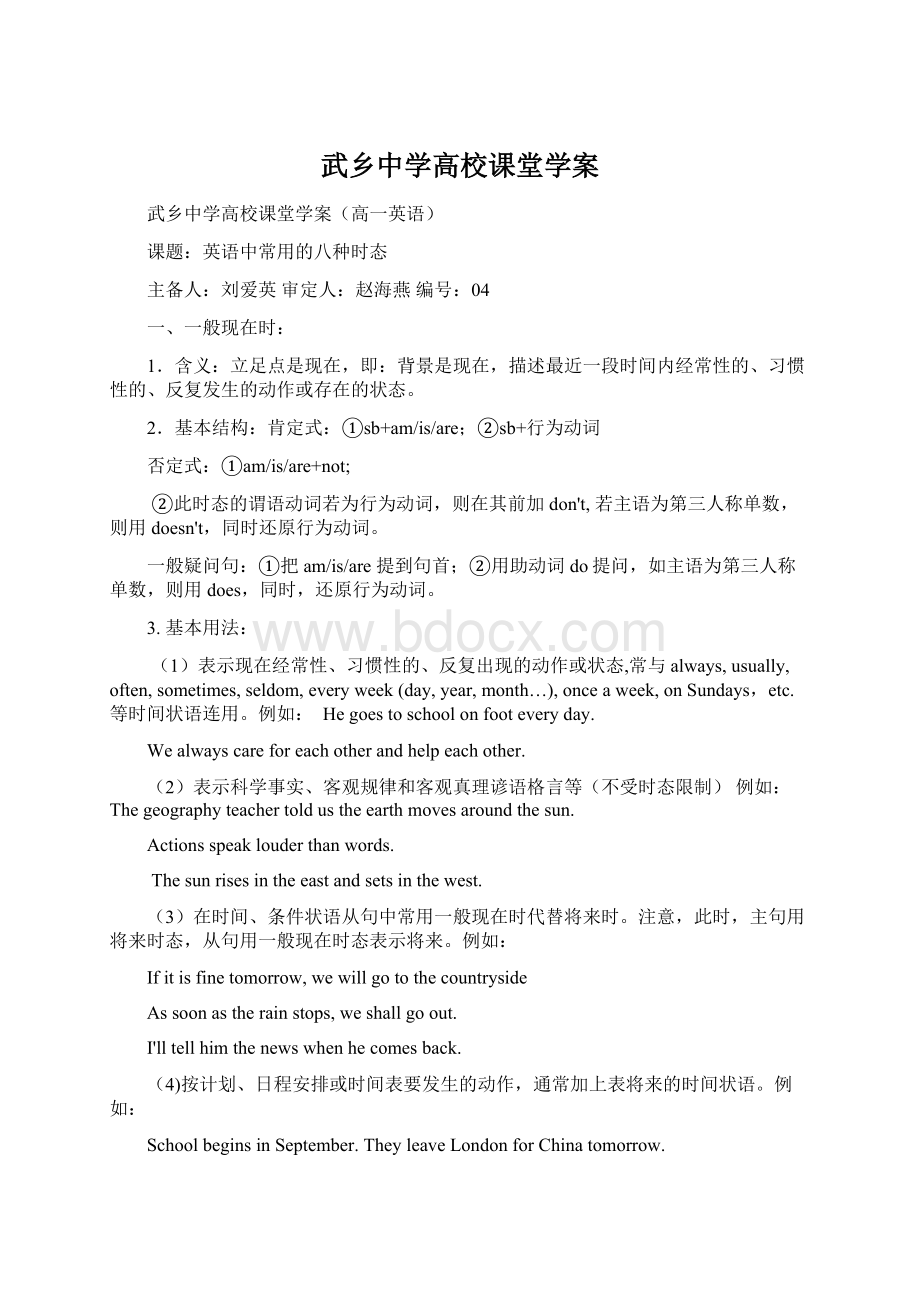武乡中学高校课堂学案.docx
《武乡中学高校课堂学案.docx》由会员分享,可在线阅读,更多相关《武乡中学高校课堂学案.docx(11页珍藏版)》请在冰豆网上搜索。

武乡中学高校课堂学案
武乡中学高校课堂学案(高一英语)
课题:
英语中常用的八种时态
主备人:
刘爱英审定人:
赵海燕编号:
04
一、一般现在时:
1.含义:
立足点是现在,即:
背景是现在,描述最近一段时间内经常性的、习惯性的、反复发生的动作或存在的状态。
2.基本结构:
肯定式:
①sb+am/is/are;②sb+行为动词
否定式:
①am/is/are+not;
②此时态的谓语动词若为行为动词,则在其前加don't,若主语为第三人称单数,则用doesn't,同时还原行为动词。
一般疑问句:
①把am/is/are提到句首;②用助动词do提问,如主语为第三人称单数,则用does,同时,还原行为动词。
3.基本用法:
(1)表示现在经常性、习惯性的、反复出现的动作或状态,常与 always,usually,often,sometimes,seldom,everyweek(day,year,month…),onceaweek,onSundays,etc. 等时间状语连用。
例如:
He goes to school on foot everyday.
We always care for each other and help each other.
(2)表示科学事实、客观规律和客观真理谚语格言等(不受时态限制) 例如:
The geography teacher told us the earth moves around the sun.
Actions speak louder than words.
Thesunrisesintheeastandsetsinthewest.
(3)在时间、条件状语从句中常用一般现在时代替将来时。
注意,此时,主句用将来时态,从句用一般现在时态表示将来。
例如:
If it is fine tomorrow, we will go to the countryside
Assoonastherainstops,weshallgoout.
I'lltellhimthenewswhenhecomesback.
(4)按计划、日程安排或时间表要发生的动作,通常加上表将来的时间状语。
例如:
SchoolbeginsinSeptember.TheyleaveLondonforChinatomorrow.
二、一般过去时:
1.含义:
立足点是现在,即:
背景是现在,描述过去某个时间里发生的动作或状态。
标志性的词有:
ago,yesterday,thedaybeforeyesterday,lastweek(year,night,month…),in1989,justnow,attheageof5,oneday,theotherday,onceuponatime.
2.基本结构:
肯定式:
sb+动词的过去式
I wanted to watch animals in the zoo. They took his son to the cinema.
否定式:
①was/were+not;
(2)sb+didn’t+动词原形
I didn’t have his telephone number。
一般疑问句:
①was或were放于句首;②用助动词do的过去式did提问,同时还原行为动词。
3.基本用法:
1) 表示过去经常性、习惯性、反复发生的动作或状态(never ,often ,always,usually)
e.g.)Heoftencametoschoolbybikelastyear. He wasalways readytohelpothers.
2)表示过去发生的动作或存在的状态。
常与之连用的时间状语有yesterday,lastweek/year,afewyearsago,justnow等。
e.g. I met her in the street yesterday.
LastSundaywevisitedtheGreatWall.
3)根据时态一致,在宾语从句中用一般过去时代替一般现在时
e.g.She asked weather they needed some more tea.
He said that there wasn’t time to go to the city century.
He told me he read an interesting novel last night.
4) 由于when,while,before,after,whenever等引导的表示过去时间的状语从句常用过去时.
e.g.The boy began to go to school when he was five.
They lived there before they came to China.
三、现在进行时:
1.含义:
以现在为背景,表示说话时正在进行的动作或存在的状态。
标志性的词有:
now,atthistime,thesedays,etc.
2.基本结构:
肯定式:
am/is/are+doing
否定形式:
am/is/are+not+doing.
一般疑问句:
把am/is/are放于句首。
3.【基本用法】
(1)表示"说话、写文章的当刻"正在发生的动作。
Thetelephoneisringing.Wouldyoupleaseanswerit?
Theyarewaitingforus.Let’shurryup.
(2)表示现阶段正在进行的动作,说话时动作不一定正在进行。
Thecouplearesavingmoneytobuyanewhouse.
这两口子在攒钱买新房。
(3)表示说话人的某种感情色彩,如赞叹、惊讶、厌烦、不满等。
通常与always, constantly, continually, all the time, all along, 等连用,这时的动作并不是正在发生或进行,而是表示经常性,相当于"一般现在时"所描述的情况。
Heisalwaysthinkingofothers,notofhimself.(表示赞许)
他总是为他人着想,而不为自己。
Sheisoftendoingwellatschool.(表示满意)她在学校学习挺不错的。
Areyoufeelingbettertoday?
(表示亲切)你今天觉得好一些吗?
She is always borrowing money and forgetting to pay me back.
(表示不满)
(4)表示在近期按计划或安排要发生的动作,用于这种情况仅限于少量的动词,如:
go,come,leave,start,arrive,see,have,lunch(吃午饭),return,dine(进餐,尤指晚餐),work,sleep,stay,play,do,wear(穿,戴)等。
例如:
I'mdinningoutwithmyfriendsthisevening.
今晚我将和朋友在外面吃饭。
AnAmericanprofessorisgivingalecturethisafternoon.今天下午一位美国教授要来作报告。
WearehavingaholidaynextWednesday.下周三我们放假。
注意:
下面四类动词不宜用现在进行时。
(A)表示心理状态、情感的动作:
like, love, hate, care, remember, believe, want, mind, wish, agree, mean, need.(B)表存在的状态的动词
:
appear, exist, lie, remain, seem belong to, depend on。
(C)表示一时性动作的动词:
allow, accept, permit, promise, admit, complete。
(D)表示感官的动词:
see, hear, notice, feel, smell, sound, taste, look
四.过去进行时:
1.含义:
以过去为背景,表那时正在进行的动作或存在的状态。
常用的时间状语有atthistimeyesterday,atthattime或以when引导的谓语动词是一般过去时的时间状语等。
2.基本结构:
肯定式:
sb+was/were+doing
否定形式:
was/were+not+doing.
一般疑问句:
把was或were放于句首
3.基本用法:
(1)表示过去某一时刻正在进行的动作
Whatwereyoudoingat9lastnight.昨天晚上九点钟你在干什么?
Atthismomentyesterday,Iwasdoingmyhomework.
WhenIcametoseeherlasttime,shewaswritinganarticle.
(2)表示过去某一段时间正在进行的动作,说话的那一刻动作不一定正在进行。
Theysaidtheyweresavingmoneytobuyahouse.
他们说他们在攒钱买房子。
(3)用于故事的开头,交代故事发生的背景情况。
过去进行时所描述的动作是”正在进行”,所以,在这种情景中用”过去进行时”可以给读者一种”动感”,从而能使文章更加生动活泼。
例如:
Onenight,hewastypinginhisstudy.Suddenly,amanbrokeintohishouseandcutofftheelectricity….一天晚上,他正在书房里打字。
突然,一个人闯进屋来,切断了电源…
五.现在完成时:
1.含义:
背景是现在,描述过去发生某事,当即就结束(短暂性动词),但动作后果影响到现在;或过去发生某事,动作持续到现在结束(持续性动词)。
现在完成时的时间状语:
recently,lately,since…for…,inthepastfewyears,etc.
2.基本结构:
肯定式:
sb.have/has+done
否定形式:
have/has+not+done.
一般疑问句:
把have或has提前。
.
3.基本用法:
1)表示发生在过去而对现在产生影响、带来结果的动作
Shehasread150pagestoday.
Theyhavedevelopedanewproduct.
Haveyouhadyourdinner?
ShehasbeentotheUnitedStates.她已去美国了。
Youhavegrownmuchtaller.你长高了许多。
2)表示过去发生的动作持续到现在,并可能还要延续,经常与之连用的时间状语有for+时间段,since+时间点,thesedays,thismorning,sofar,recently,(ever)since,lately,in/for/over/duringthepast+时间段。
Ithasbeenfiveyearssincehejoinedthearmy.他参军五年了。
TheyhavelearnedEnglishforeightyears.
六.过去完成时:
1.含义:
以过去某个时间为标准,在此以前发生的动作或行为,或在过去某动作之前完成的行为,即“过去的过去”。
与之连用的时间状语:
before,bytheendoflastyear(term,month…),etc.
2.基本结构:
肯定式:
sb.had+done.
否定形式:
sb.had+not+done.
一般疑问句:
had放于句首。
3.基本用法:
1)表示“过去的过去”,两个动作有明显的先后关系。
He told me that he had made great progress since he came here.
2)在by、by the end、by the time、until、before、since后接表示过去某一时间的短语或从句以前发生的动作。
如:
By the end of last year, we had produced 20,000 cars.
The train had left before we reached the station.
◆3)用在表示“一……就”的几个句型中:
Hardly/scarcely…when, no sooner…than,
Hardly / No sooner + 主语 + 过去分词 + when / than / + 一般过去时。
如:
We had no sooner been seated than the bus started.
= No sooner had we been seated than the bus started. 我们刚一坐下,车子就启动了。
Hardly had the thief seen the police when he ran away.
◆4)“时间名词 + before”在句子中作状语,谓语动词用过去完成时;“时间名词 + ago”在句中作状语,谓语动词用一般过去式。
如:
He said his first teacher had died at least 10 years before.
Xiao Hua left school 3 years ago.
◆5)在before或after引导的时间状语从句中用一般过去时代替过去完成时。
After he (had)left the room, the boss came in.
We arrived home before it snowed.
七.一般将来时
1.含义:
立足点是现在,即现在看来将要发生的动作或存在的状态。
与之常用的时间状语:
tomorrow,nextday(week,month,year…),soon,inafewminutes,thedayaftertomorrow,etc.
2.基本结构:
肯定式:
sbwill/shall+dosth.
否定形式:
sbwill/shallnotdosth.
一般疑问句:
will/shall提到句首。
eg.Will you be free tonight?
We will know the result tomorrow.
3.一般将来时的其他表达法:
1)be(am/is/are)+going+不定式, 这种表示方法主要是说明A)"说话人的意图、打算";B)从…迹象上看将要…(根据现在的迹象对未来进行推测)
肯定式:
主语+am/is /are +going to 动词原形
否定形式:
都是在/am/is /are这些助动词后加not即可。
一般疑问:
把助动词am/is /are 提前。
例如:
A)HeisgoingtospendhisholidaysinLondon.他打算在伦敦度假。
Whoisgoingtospeakfirst?
谁先发言?
B)Lookattheblackclouds.Itisgoingtorainsoon.
2)be(am/is/are)+不定式,描述两种情况:
A)按计划安排要发生的动作,这个动作发生的时间一般不会很远;B)要求或命令他人做某事。
例如:
A)Thenewtermistostartinthreedays.
B)Youarenottobringanymobilecommunicationmeansintotheexam-room.任何移动通讯工具都不得带入考场。
Youaretostayhomeuntilyourmothercomesback.你妈回来之前你不要出去。
3)be about to do(表示马上就要发生的事,不能与表将来的时间状语连用。
)
Silenceplease,silence!
Themeetingisabouttobegin.
4)用一般现在时或现在进行时(限于某些动词,如come,go,leave, start,arrive,finish,)表示按计划安排要发生的事。
主要强调"按计划安排要发生的事"。
例如:
Doyougetoffatthenextstop?
你下一站下车吗?
Theplanetakesoffat11:
00a.m.那架飞机上午十一点起飞。
Mr.WhiteisleavingforNewYorknextweek.怀特先生下周动身去纽约。
八.过去将来时:
1.含义:
立足于过去某一时刻,即在过去某一时间点看来将要发生的动作或存在的状态。
2.基本结构:
1)肯定式:
sb.would+do.
否定形式:
sb.would+not+do.
一般疑问句:
would提到句首。
2)sb.was/wereaboutto+动词原形,表示过去计划或安排将要做某事.
例如:
Bettyaskediftherewasgoingtobeaconcertthatevening.
3.基本用法:
A)常用于宾语从句或间接引语中;B)表示过去习惯性的动作。
例如:
A)WhenIthoughtaboutit,Iwonderedwhattheirreactionwouldbe.当我考虑这件事时,我想知道他们的反应是什么。
ShetoldmethatshewouldgoontriptoEuropethenextday.她告诉我,她第二天要去欧洲旅行。
B)Duringthatperiod,hewoulddomorning-exerciseseveryday.在那段时间,他每天早锻炼。
【实战演练】八种时态分类练习
初中英语8种时态分类练习
一.一般现在时与现在进行时专练
()1.OldTomusually______upatsixand______sportsinthegarden.
A.gets,dosB.gets,doesC.get,doesD.gets,do
()2.Don’tmakesomuchnoise.We_____tothemusic.
A.arelisteningB.listenC.listenedD.havelistened
()3.---WhatisTomdoingintheclassroom?
---He______somethingontheblackboard.
A.drawsB.drawC.isdrawingD.aredrawing.
()4I______aletter,soIcan’tgooutwithyou.
A.iswritingB.amwritingC.amwriteingD.amwritting
()5.Thepicture______nice.A.looksB.islookedC.lookD.islooking
()6.ThestudentswillgototheSummerPalaceifit______tomorrow.
A.don’trainB.doesn’trainC.won’trainD.isn’train
()7.Wearealwaysready_______others.
A.tohelpingB.tohelpC.helpD.helping
( )8.DoesMrKnow-allknow______keys?
A.tomakeB.howtomakeC.howmakeD.making
()9--WhereisPeter?
--He______hishomeworkintheroom.
A.isdoingB.doesC.didD.do
()10.Theclothes______verysoft.A.arefeltB.arefeelingC.feelD.feels
二.一般过去时专练
()1.Themotheraskedtheboy_______downtheladder,buthewenton_______instead.
A.come;climbingB.tocome;toclimbC.tocome;climbingD.coming;climbing
()2.Theteacheraskedthestudentstoclosethewindows_______thewindfrom_______thepapersaway.
A.tostop;blowingB.stopping;blowingC.tostop;blowD.stopped;blow
()3.Thesickmanstayedinbed,_______veryterrible.
A.feltB.feelingC.isfeelingD.wasfeeling
()4.Isawhim_______intothesmallstore.
A.wentB.goingC.togoD.hasgone
()5.Heraisedhisvoicetomakeeverybodyintheroom______himclearly.
A.hearB.tohearC.hearingD.heard
()6.Ourgeographyteachertoldusyesterdaythattheearth_______aroundthesun.
A.wasmovingB.movedC.hasmovedD.moves
()7.---Howwasyour